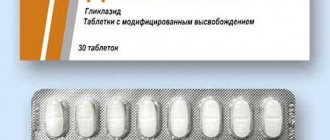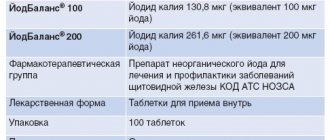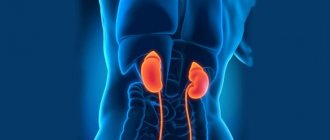Pharmacological properties of the drug Amaryl
Pharmacodynamics . Glimepiride is an oral hypoglycemic drug, a sulfonylurea derivative. The effect of glimepiride is realized by stimulating the release of insulin from pancreatic β-cells. Like other sulfonylureas, it increases the responsiveness of pancreatic β-cells to physiological stimulation by glucose. In addition, glimepiride, like other sulfonylurea derivatives, apparently has a pronounced extrapancreatic effect. Release of insulin. Sulfonylurea regulates insulin secretion by closing ATP-dependent potassium channels on the β-cell membrane. This closure leads to depolarization of the cell membrane, as a result of which calcium channels open slightly and a large amount of calcium enters the cell. This stimulates the release of insulin by exocytosis. Glimepiride binds with high tropism to a protein on the β-cell membrane associated with the ATP-dependent potassium channel, but not at the site to which sulfonylureas typically bind. Extrapancreatic activity. The extrapancreatic effect consists, in particular, of increasing the sensitivity of peripheral tissues to insulin and reducing the uptake of insulin by the liver. Transport of glucose from the blood to peripheral muscle and fat tissues occurs through special transport proteins localized on the cell membrane. It is the transport of glucose to these tissues that is the stage that limits the rate of glucose uptake. Glimepiride very quickly increases the number of active glucose transporters on the plasmalemma of muscle and fat cells, thereby stimulating glucose uptake. Glimepiride increases the activity of phospholipase C, specific for glycosyl-phosphatidylinositol. This may be due to the increased lipogenesis and glycogenesis that is observed in isolated fat and muscle cells under its influence. Gimepiride prevents the formation of glucose in the liver, increasing the intracellular concentration of fructose-2, 6-diphosphate, which, in turn, inhibits gluconeogenesis. General information. For healthy individuals, the minimum effective oral dose is 0.6 mg. The effect of glimepiride is dose-dependent and reproducible. The physiological response to intense physical activity, manifested by a decrease in insulin secretion, persists after taking glimepiride. There was no significant difference in the effect of the drug taken 30 minutes before or immediately before a meal. In patients with diabetes mellitus, a single daily dose can provide optimal metabolic control for 24 hours. Although the hydroxy derivative (a metabolite of glimepiride) causes a slight but statistically significant decrease in plasma glucose levels in healthy people, its effect on the overall effect of the drug is insignificant. Combination therapy with metformin. One study showed that for patients whose maximum daily dose of metformin did not provide sufficient metabolic control, concomitant therapy with glimepiride improved this control. Combination therapy with insulin. Data regarding the use of combination therapy with insulin are limited. For patients in whom the maximum daily dose of glimepiride did not provide sufficient glycemic control, concomitant insulin therapy can be started. Two studies found that combination treatment improved metabolic control as well as insulin monotherapy, but lower doses of insulin could be used during combination therapy. Pharmacokinetics. Absorption. The bioavailability of glimepiride after oral administration is complete. Eating does not have a significant effect on absorption, only its rate is slightly reduced. The maximum concentration (Cmax) in blood plasma is reached approximately 2.5 hours after oral administration (average 0.3 mcg/ml over several daily doses of 4 mg). There is a linear relationship between dose and Cmax and AUC. Distribution. Glimepiride has a very low volume of distribution (approximately 8.8 L), which is approximately equal to the volume of distribution of albumin, has a high degree of protein binding (99%) and low clearance (approximately 48 ml/min). In animals, glimepiride is excreted in milk. Glimepiride can cross the placenta, but does not penetrate the blood-brain barrier well. Biotransformation and elimination. The average half-life, which depends on the concentration in the blood plasma, when using multiple doses, is 5-8 hours. After taking high doses, a slight prolongation of the half-life was observed. After administration of a single dose of radiolabeled glimepiride, 58% of the label was found in the urine and 35% in the feces. The substance is not detected in unchanged form in the urine. Two metabolites are excreted in urine and feces, most likely products of metabolism in the liver (the main enzyme is cytochrome P2C9): a hydroxy derivative and a carboxy derivative. After oral administration of glimepiride, the terminal half-lives of these metabolites were 3–6 hours and 5–6 hours, respectively. A comparative analysis showed no significant differences in pharmacokinetics after single and repeated use of the drug, and the variability of results for one individual was very low. No significant accumulation was observed. Pharmacokinetics were similar in men and women, as well as in young and elderly (over 65 years of age) patients. For patients with low creatinine clearance, there was a trend toward increased clearance and decreased mean serum concentrations of glimepiride, most likely due to its more rapid elimination due to poorer protein binding. The excretion of 2 metabolites by the kidneys decreased. There was no additional risk of drug accumulation in these patients. In five patients without diabetes mellitus after bile duct surgery, pharmacokinetics were similar to those in healthy subjects.
Use of the drug Amaryl
Successful treatment of diabetes depends on the patient's adherence to an appropriate diet, regular physical activity, and constant monitoring of blood and urine glucose levels. The patient's failure to comply with the diet cannot be compensated for by taking pills or insulin. The drug is used by adults. Dosing depends on the results of blood and urine glucose tests. The initial dose is 1 mg (1/2 tablet of 2 mg) of glimepiride per day. If such a dose achieves disease control, it should be used for maintenance therapy. If glycemic control is not optimal, the dose should be increased to 2, 3 or 4 mg glimepiride per day in stages (at intervals of 1-2 weeks). Doses greater than 4 mg per day provide better results only in selected cases. The maximum recommended dose is 6 mg of Amaryl per day. If the maximum daily dose of metformin does not provide sufficient glycemic control, the patient may be started on concomitant therapy with glimepiride. While maintaining the previous dosage of metformin, the drug should be started with a low dose, which can then be gradually increased to the maximum daily dose, focusing on the desired level of metabolic control. Combination therapy should be carried out under the supervision of a physician. If the maximum daily dose of Amaryl does not provide sufficient glycemic control, concomitant insulin therapy may be initiated if necessary. While maintaining previous glimepiride dosing, insulin treatment should begin at a low dose, which can then be increased based on the desired level of metabolic control. Combination therapy should be carried out under close medical supervision. Usually one dose of Amaryl per day is enough. It is recommended to take it shortly before or during a substantial breakfast or (if there is no breakfast) shortly before or during the first main meal. Errors in the use of the drug, such as missing a dose, should never be corrected by taking a subsequent higher dose. The tablet should be swallowed without chewing, washed down with liquid. If a patient develops a hypoglycemic reaction to a dose of 1 mg per day, this means that the disease can only be controlled by diet. Improved control of diabetes mellitus is accompanied by an increase in insulin sensitivity, so the need for glimepiride may decrease during the course of treatment. To avoid hypoglycemia, the dose should be gradually reduced or therapy should be interrupted altogether. The need to review dosage may also arise if the patient's body weight or lifestyle changes or other factors increase the risk of hypo- or hyperglycemia. Switching from oral hypoglycemic agents to Amaryl . You can usually switch from other oral hypoglycemic drugs to taking Amaryl. During such a transition, the potency and half-life of the previous agent should be taken into account. In some cases, especially if the antidiabetic drug has a long half-life (for example, chlorpropamide), it is recommended to wait several days before taking Amaryl. This will reduce the risk of hypoglycemic reactions due to the additive effect of the two drugs. The recommended starting dose is 1 mg glimepiride per day. As noted above, the dose can be increased in stages based on response to the drug. Switching from insulin to Amaryl . In exceptional cases, patients with type II diabetes mellitus receiving insulin may be advised to replace it with Amaryl. This transition should be carried out under close medical supervision.
Amaryl's analogs
A foreign analogue of Amaryl is the drug Glimepiride-Teva. It is produced by the Croatian company Pliva Hrvatska.
Russian analogues of the drug Amaryl are:
- Glemaz, from the Valiant company.
- Glimepiride from the companies Atoll, Pharmproject, Pharmstandard and Vertex.
- Diamerid from the Akrikhin company.
- Glimepiride Canon from the company Kanonpharma.
All manufacturers produce their drugs in dosages of 1, 2, 3, 4 mg. The cost of a specific drug must be clarified at pharmacies.
Side effects of the drug Amaryl
Based on the experience with the use of Amaryl and other sulfonylurea derivatives, it is necessary to take into account the possibility of developing the following side effects of the drug: From the blood and lymphatic system Sometimes: moderate to severe thrombocytopenia, leukopenia, granulocytopenia, agranulocytosis, erythrocytopenia, hemolytic anemia and pancytopenia, which are usually disappear after stopping treatment. Immune disorders Very rare: allergic vasculitis, mild hypersensitivity reactions, which can progress to severe forms with the development of dyspnea, decreased blood pressure, and sometimes shock. Possible cross-allergy with sulfonylureas, sulfonamides or related compounds. Metabolism: Sometimes: hypoglycemic reactions, which mostly occur immediately, can become severe and are not always easy to correct. The occurrence of these reactions depends, as with other types of hypoglycemic therapy, on subjective factors such as dietary habits and dosage. Organ of vision During treatment (especially at the beginning), transient visual impairment may be observed due to changes in blood glucose levels. From the gastrointestinal tract Very rarely: nausea, vomiting, diarrhea, pressure or sensations of fullness in the stomach, abdominal pain, which rarely may require discontinuation of therapy. From the hepatobiliary system Increased levels of liver enzymes may be observed. Very rare: liver dysfunction (eg bile stagnation and jaundice), hepatitis, which may progress to liver failure. Skin and subcutaneous tissue disorders Hypersensitivity reactions - itching, rash and urticaria. Very rare: photosensitivity. Laboratory values Very rare: hyponatremia.
Special instructions for the use of the drug Amaryl
Amaryl should be taken shortly before or during meals. If meals are taken at different times each time or are skipped altogether, taking the drug may cause hypoglycemia. Symptoms of hypoglycemia may include: headache, severe hunger, nausea, vomiting, fatigue, drowsiness, sleep disturbances, anxiety, aggressiveness, impaired concentration and reaction time, depression, disorientation, speech and vision disorders, aphasia, tremor, paresis, impairment sensitivity, dizziness, helplessness, loss of self-control, delirium, convulsions, fainting, up to the development of coma, shallow breathing and bradycardia. In addition, signs of adrenergic counterregulation such as hyperhidrosis, clammy skin, anxiety, tachycardia, hypertension, palpitations, angina pectoris, and cardiac arrhythmia may occur. The clinical picture of a severe hypoglycemic attack may resemble a stroke. Symptoms can almost always be quickly reduced by taking carbohydrates (sugar) immediately. Artificial sweeteners will not be effective. Based on experience with other sulfonylurea derivatives, it is known that treatment measures may initially be successful, but despite this, symptoms of hypoglycemia may reappear. Severe or prolonged hypoglycemia, which can only be temporarily relieved by eating regular amounts of sugar, requires immediate medical treatment and sometimes hospitalization. Factors contributing to hypoglycemia:
- reluctance or (more often in older patients) inability to maintain productive contact with a doctor;
- malnutrition, irregular or skipped meals, periods of fasting;
- change in diet;
- imbalance between physical activity and carbohydrate consumption;
- drinking alcohol, especially in combination with skipping meals;
- renal failure;
- severe liver dysfunction;
- Amaryl overdose;
- certain uncompensated disorders of the endocrine system affecting the metabolism of carbohydrates, or the inverse regulation of hypoglycemia (for example, certain dysfunctions of the thyroid gland, insufficiency of the anterior pituitary gland or adrenal cortex), simultaneous use of certain medications (see INTERACTIONS ).
Treatment with Amaryl requires constant monitoring of glucose levels in the blood and urine. In addition, it is recommended to control the amount of glycosylated hemoglobin. During use of the drug, regular monitoring of liver function and blood count (especially the number of leukocytes and platelets) is necessary. In stressful situations (for example, accidents, urgent operations, infections accompanied by fever), a temporary transfer of the patient to the use of insulin may be indicated. There are no data regarding the use of Amaryl for patients with severe liver dysfunction or those for whom dialysis is indicated. Patients with severe renal or hepatic impairment should be switched to insulin. The drug is contraindicated in patients with rare hereditary galactose intolerance, lactase deficiency or glucose-galactose malabsorption. Pregnancy period Risk associated with diabetes. Deviations from normal blood glucose levels during pregnancy may increase the likelihood of birth defects and perinatal mortality. Therefore, it is necessary to carefully monitor glycemia during pregnancy to avoid teratogenic risk. During pregnancy, insulin should be used. If you become pregnant, you should inform your doctor. Risk associated with glimepiride. There are no data regarding the use of glimepiride during pregnancy. According to the results of animal experiments, the drug has a toxic effect on reproductive function, probably associated with the pharmacological (hypoglycemic) effect of glimepiride. Therefore, glimepiride is contraindicated throughout pregnancy. When using glimepiride and planning or becoming pregnant, the woman should be switched to insulin therapy as soon as possible. Breastfeeding It is not known whether glimepiride is excreted in breast milk. Glimepiride is known to pass into the breast milk of rats. It is recommended to discontinue treatment with glimepiride during breastfeeding, since other sulfonylureas are detected in breast milk and there is a risk of hypoglycemia in the newborn. Impact on the ability to drive vehicles or operate machinery . The ability to concentrate and reaction time may be reduced due to hypoglycemia or hyperglycemia or, for example, due to deterioration of vision. This may create a risk in situations where such ability is particularly important (for example, driving a car or operating machinery). The patient should be warned not to develop hypoglycemia while driving. This is especially true for those individuals who have little or no ability to recognize the warning signs of hypoglycemia, and those who experience frequent episodes of hypoglycemia. The need to drive or operate machinery under these circumstances must be carefully considered.
Drug interactions Amaryl
Concomitant use of Amaryl with certain medications can cause both a decrease and an increase in the hypoglycemic effect of glimepiride. Therefore, other drugs should be taken only as directed or with the advice of a doctor. Glimepiride is metabolized by cytochrome P450 2C9 (CYP2C9). It is known that due to simultaneous administration of inducers (for example, rifampicin) or inhibitors of CYP2C9 (for example, fluconazole), this metabolism may be altered. Results from an in vivo showed that fluconazole, one of the most potent inhibitors of CYP2C9, approximately doubled the AUC of glimepiride. The existence of these types of interactions is evidenced by the experience of using Amaryl and other sulfonylurea derivatives. Potentiation of the hypoglycemic effect, and therefore, in some cases, hypoglycemia, may occur in case of simultaneous use of glimepiride with such drugs as phenylbutazone, azapropazone and oxyphenbutazone, sulfinpyrazone, insulin and oral antidiabetic drugs, some long-acting sulfonamides, metformin, tetracyclines, salicylates and PAS, MAO inhibitors, anabolic steroids and male sex hormones, quinolone antibiotics, chloramphenicol, probenecid, coumarin anticoagulants, miconazole, fenfluramine, pentoxifylline (when used parenterally in high doses), fibrates, tritoqualine, ACE inhibitors, fluconazole, fluoxetine, allopurinol, sympatholytics , cyclo-, tro- and ifosfamides. A decrease in the hypoglycemic effect and, accordingly, an increase in blood glucose levels can occur with the simultaneous use of the following drugs: estrogens and progestogens, saluretics, thiazide diuretics, drugs that stimulate thyroid function, glucocorticoids, phenothiazine derivatives, chlorpromazine, adrenaline and sympathomimetics, nicotinic acid (in high dose) and its derivatives, laxatives (long-term use), phenytoin, diazoxide, glucagon, barbiturates and rifampicin, acetozolamide. H2-receptor antagonists, β-adrenergic receptor blockers, clonidine and reserpine can lead to both potentiation and reduction of the hypoglycemic effect. Under the influence of sympatholytics, such as beta-adrenergic blockers, clonidine, guanethidine and reserpine, the manifestations of adrenergic counterregulation of hypoglycemia may be reduced or absent altogether. Alcohol consumption may increase or decrease the hypoglycemic effect of glimepiride in unexpected ways. Glimepiride can both increase and decrease the effect of coumarin derivatives.
Reviews
Amaryl is more expensive than Maninil or Diabeton MV. Therefore, not a very large number of people use it to treat diabetes. This explains the fact that there are not too many reviews about it.
Patients consider the positive properties of the drug to be that it allows you to lower blood sugar levels, and you need to take it once a day.
Negative reviews concern that Amaryl can cause hypoglycemia, and over time it leads to problems with the pancreas.
Author of the article:
Alekseeva Maria Yurievna |
Therapist Education: From 2010 to 2021 practicing physician at the therapeutic hospital of the central medical unit No. 21, the city of Elektrostal. Since 2021 he has been working at diagnostic center No. 3. Our authors
Amaryl drug overdose, symptoms and treatment
May lead to hypoglycemia, which lasts from 12 to 72 hours, and after the first reduction in the severity of symptoms, it may reappear. Symptoms may appear 24 hours after absorption of the drug. In general, in-clinic observation is recommended for such patients. Nausea, vomiting and epigastric pain may occur. Hypoglycemia can often be accompanied by neurological symptoms such as restlessness, tremors, blurred vision, coordination, drowsiness, coma and seizures. Treatment consists primarily of preventing drug absorption. To do this, you need to induce vomiting, drink water or lemonade, take activated charcoal and sodium sulfate. If a large amount of glimepiride is taken, gastric lavage is indicated, followed by the use of activated carbon and sodium sulfate. In case of severe overdose, hospitalization in the intensive care unit is necessary. Glucose administration should be started as soon as possible: if necessary, first a one-time intravenous injection of 50 ml of 50% solution, and then an infusion of 10% solution, constantly monitoring glycemia. Further treatment is symptomatic. When treating hypoglycemia, especially in young children who have accidentally taken Amaryl, the dose of glucose administered should be carefully monitored to avoid the possible development of dangerous hyperglycemia. It is important to constantly monitor glycemia.
Contraindications
Amaryl is contraindicated for the following diseases:
- Diabetes mellitus type 1 (insulin dependent);
- Diabetic ketoacidosis (complication of type 1 diabetes);
- Severe kidney and liver diseases;
- Diabetic coma and precoma preceding it;
- Glucose-galactose malabsorption, lactase deficiency, galactose intolerance;
- Childhood;
- Individual intolerance to any component of Amaryl;
- Pregnancy and lactation.











